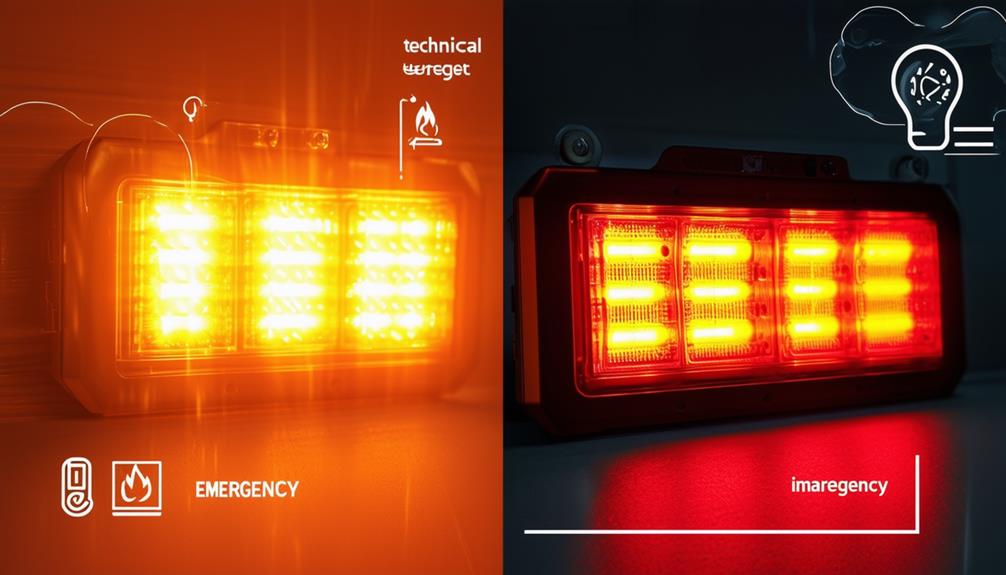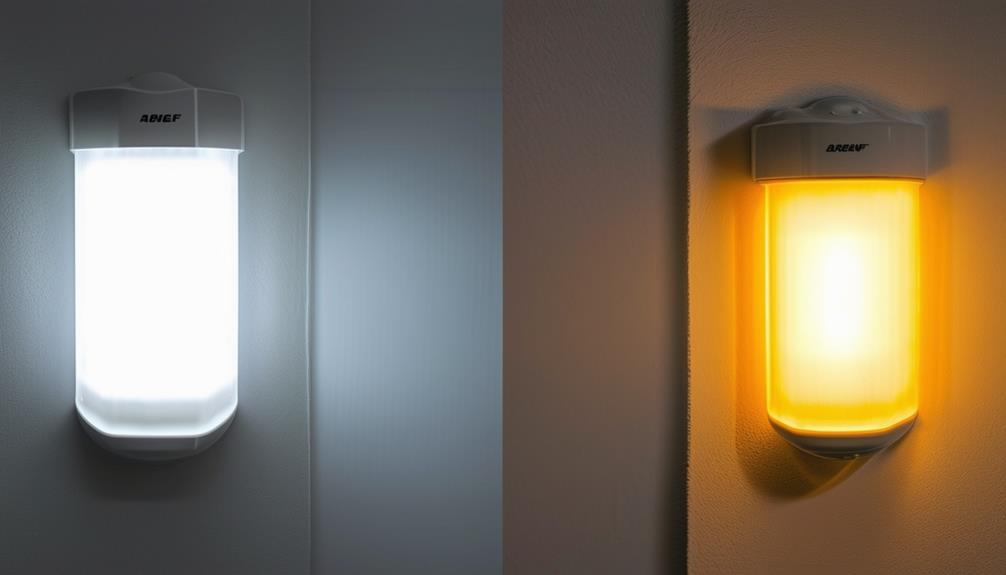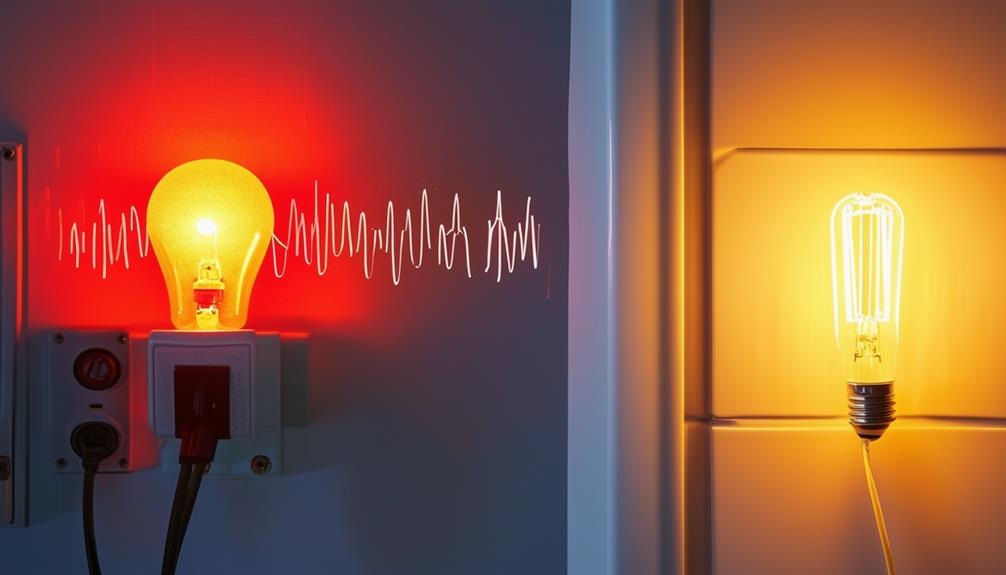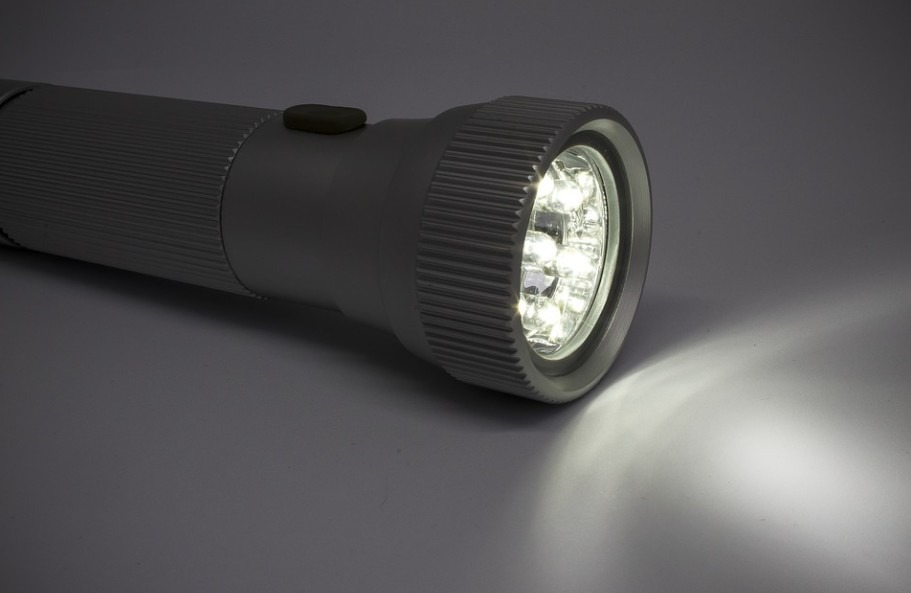Comparing LED Vs. Incandescent Emergency Lights

When comparing LED and incandescent emergency lights, distinct differences emerge that could influence your decision. LEDs are renowned for their efficiency and longevity, often lasting thousands of hours longer than incandescent bulbs. They also consume less energy, which can result in substantial cost savings over time.
However, the initial investment for LED lights is typically higher, complicating the decision. Are the long-term benefits worth the upfront expenses? Additionally, how do factors like brightness and maintenance requirements impact your choice? These considerations are crucial in making an informed decision.
Efficiency Comparison

When it comes to efficiency, LED emergency lights significantly outperform their incandescent counterparts. LEDs utilize an electroluminescence process, which is fundamentally more efficient than the filament-heating method employed by incandescent bulbs. This difference in technology means that LED lights convert more energy into visible light, minimizing energy loss as heat.
LED emergency lights offer about 30% energy savings compared to incandescent bulbs. This translates to lower energy consumption and cost savings over time, making LEDs a more economical choice in the long run.
Additionally, LEDs have design advantages. Without a filament, LEDs are both thinner and lighter, which makes them easier to install and more versatile in various emergency lighting setups.
The absence of a filament also reduces the likelihood of mechanical failure, enhancing reliability when you need it most.
Lifespan Differences
LED emergency lights offer a significantly longer lifespan compared to incandescent emergency lights, often lasting up to 50,000 hours. In fact, LED lights can last about 50 times longer than their incandescent counterparts, which require frequent replacements due to their burning filament that wears out quickly.
Opting for LED emergency lights means fewer bulb changes, making them a cost-efficient choice over time. This extended lifespan reduces the need for frequent maintenance, thereby lowering associated costs and minimizing inconvenience. The durability of LED lights ensures reliable performance during emergencies.
The longevity of LEDs also provides peace of mind, as you can depend on a consistent and trustworthy light source without the worry of sudden bulb failures. Investing in LED emergency lights is essentially an investment in a more robust and enduring solution.
Clearly, when considering lifespan, LEDs offer a significant advantage over traditional incandescent emergency lights.
Brightness Levels

In addition to their impressive lifespan, LED emergency lights stand out for their exceptional brightness, making them far superior to incandescent options. During an emergency, the brightness of your lighting is crucial for ensuring safety and visibility. LED emergency lights are significantly brighter than incandescent lights of the same wattage, providing a clear advantage.
LEDs deliver outstanding brightness to illuminate evacuation paths, essential during power outages or other emergencies. This enhanced brightness ensures that you and others can see obstacles clearly and move safely, reducing the risk of accidents. In contrast, incandescent emergency lights often leave areas dim and less secure due to their lower brightness levels.
LED emergency lights are among the brightest options available, greatly improving visibility in critical situations. Whether in a commercial building or a residential area, this superior brightness can make a significant difference in an emergency.
For dependability and peak performance, LED emergency lights are the optimal choice. They offer both longevity and unparalleled brightness, prioritizing safety in all scenarios.
Maintenance Requirements
LED emergency lights require significantly less maintenance compared to incandescent lights due to their longer lifespan. This extended longevity means fewer replacements, saving both time and money.
Incandescent lights, on the other hand, demand frequent bulb changes, which are both costly and time-consuming. Although regular inspections and testing are essential for all emergency lighting systems, the reduced need for frequent replacements makes LED systems easier to maintain.
LEDs are less prone to sudden burnouts and frequent malfunctions, common issues with incandescent lights. The cost benefits of LED emergency lights go beyond the initial purchase price. Lower maintenance requirements translate to long-term savings.
There's no need for constant bulb replacements, which can accumulate substantial costs over time. For professional guidance on maintaining and upgrading your emergency lighting system to LED, consider consulting Koorsen Fire & Security. They can help you enhance efficiency and further reduce maintenance expenses.
Energy Consumption

LED emergency lights are significantly more energy-efficient than incandescent options. LEDs convert nearly all their energy into visible light, while incandescent bulbs waste most of it as heat.
Therefore, switching to LEDs not only conserves energy but also reduces costs over time.
LED Energy Efficiency
LED emergency lights, utilizing the process of electroluminescence, consume significantly less energy compared to traditional incandescent bulbs. Without a filament that can burn out, LEDs are inherently more energy-efficient. This efficiency results in LEDs being approximately 30% more energy-efficient than incandescent bulbs, leading to substantial reductions in electricity bills.
One notable advantage of LEDs is their capability for digital control, allowing for optimized energy consumption. This means that only the necessary amount of light is used at any given time, further enhancing energy savings over the long term.
Additionally, the reduced energy consumption of LEDs makes them a more sustainable choice. By lowering electricity use, they help decrease overall energy demand and reduce environmental impact.
Therefore, choosing LED emergency lights is a decision that benefits both your finances and the planet.
Incandescent Energy Waste
In stark contrast to the energy efficiency of LEDs, incandescent bulbs waste about 98% of the energy they consume as heat. Only about 2% of their energy is converted into visible light, making them highly inefficient for emergency lighting purposes. Choosing incandescent bulbs means that most of the electricity is wasted as heat, which not only raises your electricity bills but also makes them a less sustainable choice.
The excessive energy consumption of incandescent bulbs strains your wallet over time, especially if you rely on them for emergency situations where consistent lighting is crucial. Incandescent bulbs aren't cost-effective due to their inefficient energy use.
Moreover, the energy waste from incandescent bulbs impacts the environment. Their excessive energy use contributes to higher greenhouse gas emissions, exacerbating environmental concerns related to energy conservation. By sticking with incandescent bulbs, you're contributing to a larger carbon footprint, an important consideration when evaluating your emergency lighting options.
Cost-Saving LEDs
LEDs offer substantial cost savings primarily due to their efficiency in energy consumption and long lifespan. LEDs typically provide around 30% energy savings compared to incandescent bulbs. While incandescent bulbs convert about 98% of energy into heat, LEDs efficiently use nearly all their energy for visible light. This efficiency leads to lower electricity bills and a reduced environmental footprint.
One of the most compelling advantages of LEDs is their remarkable longevity. LED lights can last approximately 50,000 hours longer than incandescent bulbs, significantly reducing the frequency and cost of replacements. Constantly replacing incandescent bulbs can be costly, making LEDs a more economical choice in the long term. Additionally, LED lights require less maintenance, further saving on maintenance costs.
Here's a quick comparison to illustrate these points:
| Feature | LED Lights | Incandescent Bulbs |
|---|---|---|
| Energy Efficiency | Nearly 100% used for visible light | 98% wasted as heat |
| Lifespan | 50,000 hours longer | Shorter, frequent replacements |
| Energy Savings | 30% more efficient | Less efficient |
| Replacement Frequency | Low | High |
| Maintenance Costs | Lower | Higher |
Light Diffusion
Many emergency lighting systems rely on light diffusion to ensure widespread and effective illumination. Incandescent emergency lights naturally provide diffused light, evenly spreading it during operation. This feature ensures areas are well-lit without harsh shadows or overly bright spots, which is crucial during emergencies.
Standard LED emergency lights, however, typically emit direct light, resulting in narrow beams that may not cover the area as effectively. Nevertheless, LEDs are highly adaptable. Manufacturers can modify specific components to customize LEDs for diffused light emission. These adjustments can change the visibility angles, allowing the light to spread more evenly.
For instance, LED emergency lights can be equipped with diffusers or special lenses that scatter the light, mimicking the effect of incandescent lights. This customization ensures similar widespread and effective illumination, enhancing safety and visibility during emergencies.
Thus, while LEDs naturally produce a more focused beam, appropriate modifications can make them match the diffused light quality of incandescent lights, offering flexible and efficient emergency lighting solutions.
Cost Implications

When deciding between LED and incandescent emergency lights, it's essential to consider the cost implications of each option. Although LED emergency lights may have a higher initial cost, they're more cost-effective over time due to their energy efficiency and extended lifespan.
LEDs consume less power, leading to lower electricity bills compared to incandescent lights. This energy efficiency results in significant cost savings, making LEDs a financially sound choice.
Moreover, LEDs require less maintenance and fewer replacements. Incandescent bulbs burn out faster, necessitating frequent replacements that increase ongoing costs. In contrast, LEDs have a longer lifespan, reducing the need for replacements and saving money on maintenance.
The initial investment in LED emergency lights is offset by reduced energy consumption and longer operational life, making them a durable and cost-efficient option.
While the upfront expense may be higher, the long-term savings and reliability of LEDs make them a superior choice over incandescent lights.
Professional Assistance
Koorsen Fire & Security offers expert guidance for a seamless transition to LED emergency lights, ensuring efficiency and cost-effectiveness. Their highly-trained technicians can evaluate your current emergency lighting system and recommend modifications to guarantee compliance with safety regulations. By choosing professional assistance, you'll not only upgrade to energy-efficient LEDs but also minimize maintenance efforts.
Koorsen Fire & Security manages all aspects of inspections, testing, and maintenance to ensure your facility remains compliant. LED emergency lights are known for their low maintenance needs, resulting in significant time and cost savings compared to traditional incandescent lights.
Comparison:
| Aspect | LED Emergency Lights | Incandescent Emergency Lights |
|---|---|---|
| Efficiency | High | Low |
| Maintenance | Minimal | Frequent |
| Compliance | Easily meets standards | May require frequent checks |
| Lifespan | Long-lasting | Short |
| Cost Savings | Significant over time | Higher long-term costs |
Contact Koorsen Fire & Security for a quote or consultation to upgrade your emergency lighting system. Their expertise ensures a smooth transition and ongoing compliance, providing you with a more efficient, cost-effective, and reliable emergency lighting solution.
Conclusion
In summary, LED emergency lights are a superior choice compared to incandescent ones. They're more energy-efficient, have a significantly longer lifespan, and require less maintenance.
While the initial cost may be higher, the long-term savings and reliability justify the investment. Additionally, LEDs provide better light diffusion and brightness control.
For dependable emergency lighting, LED lights are the optimal solution.




